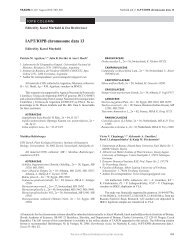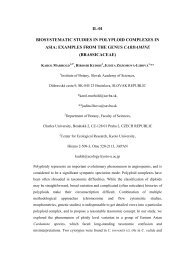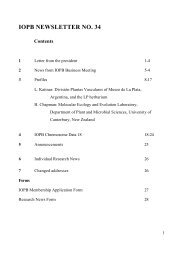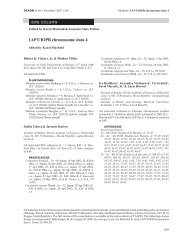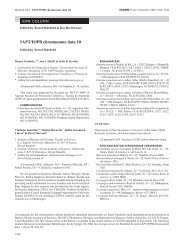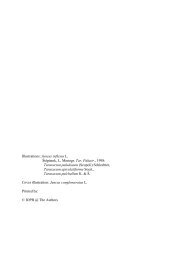CONTENS - International Organization of Plant Biosystematists
CONTENS - International Organization of Plant Biosystematists
CONTENS - International Organization of Plant Biosystematists
Create successful ePaper yourself
Turn your PDF publications into a flip-book with our unique Google optimized e-Paper software.
EVOLUTIONARY PROCESSES IN EXTRA-EUROPEAN<br />
MOUNTAINS<br />
O 41<br />
Relationships and genetic variation in the New Zealand edelweiss<br />
Leucogenes (Asteraceae: Gnaphalieae)<br />
Ilse Breitwieser & Rob Smissen<br />
Allan Herbarium, Landcare Research, PO Box 40, Lincoln 7640, New Zealand;<br />
breitwieseri@landcareresearch.co.nz<br />
<strong>Plant</strong>s <strong>of</strong> the New Zealand endemic genus Leucogenes (Asteraceae: Gnaphalieae)<br />
are alpine perennial evergreen subshrubs that are characterised by sessile yellow<br />
capitula in a very dense corymb surrounded by a ring <strong>of</strong> modified densely-white<br />
tomentose leaves, the whole giving the appearance <strong>of</strong> a single, showy flower.<br />
Beauverd named this genus Leucogenes to mark the similar appearance <strong>of</strong> the<br />
inflorescence <strong>of</strong> the New Zealand species to that <strong>of</strong> the European edelweiss,<br />
Leontopodium alpinum, and its relatives. Thus, Leucogenes became known as the<br />
New Zealand edelweiss.<br />
These similarities led some previous authors to suggest close relationships between<br />
northern and southern hemisphere edelweiss, but we found that the southern<br />
hemisphere edelweiss is part <strong>of</strong> a generic complex within the Gnaphalieae which also<br />
includes the New Zealand endemic genera Rachelia and Raoulia, the genus<br />
Anaphalioides known from New Zealand and Papua New Guinea, and the New<br />
Zealand species currently assigned to Ewartia and Helichrysum. Our observations<br />
suggest it is closest to Raoulia subg. Psychrophyton, although the two are<br />
morphologically very different. Leucogenes has the capacity to hybridise quite freely<br />
with these pulvinate species <strong>of</strong> Raoulia.<br />
We examined AFLP pr<strong>of</strong>iles, nuclear ITS sequences, and chloroplast psbA-trnH<br />
intergenic spacer sequences for representative samples <strong>of</strong> the four species <strong>of</strong><br />
Leucogenes to get more insight into the evolution and geographic variation <strong>of</strong> the<br />
species. We found that the tetraploid L. neglecta was derived from the diploid L.<br />
leontopodium by autoploidy, but that the octoploid L. tarahaoa arose earlier than and<br />
independently <strong>of</strong> L. neglecta. Some populations <strong>of</strong> L. leontopodium and L.<br />
grandiceps have chloroplast sequences more similar to those <strong>of</strong> other species <strong>of</strong> the<br />
New Zealand Gnaphalieae than to the majority <strong>of</strong> Leucogenes samples. ITS<br />
sequence variation is also complex, with sequences sampled from Leucogenes not<br />
forming a monophyletic group and siginificant intraspecific variation found within L.<br />
grandiceps.<br />
42



